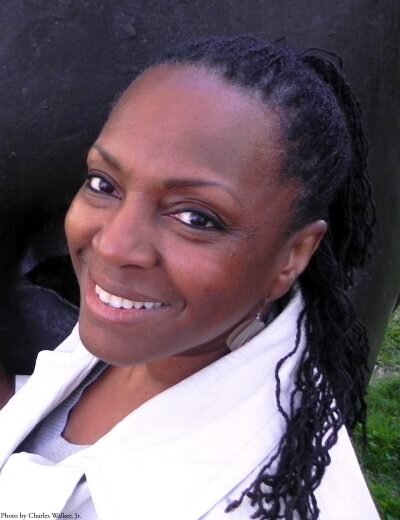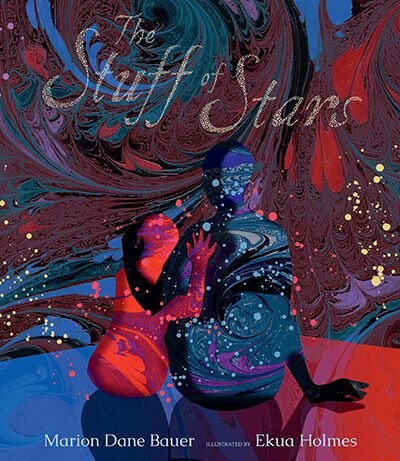An interview with Ekua Holmes
 An interview with Ekua Holmes, the amazing artist who illustrated my new picture book, The Stuff of Stars.
An interview with Ekua Holmes, the amazing artist who illustrated my new picture book, The Stuff of Stars. Ekua, my first question is a rather strange one and one I wouldn’t have asked any other artist who illustrated one of my picture books. What gave you the courage to take this project on? There is so much of the nothingness of space in the early spreads, so much no this, no that, no anything else. And even after that, the scope is so large. When I wrote the text I couldn’t even begin to imagine what an illustrator might do, especially with those early pages, but I couldn’t be more thrilled with what you have created.That is a really good question Marion. When Liz Bicknell of Candlewick Press first suggested this manuscript, I was puzzled. Why did she think this was the right manuscript for me? I am primarily a figurative artist working in the urban and southern landscapes, reflecting my upbringing and experiences. Here was the atmospheric, nebulous unfolding story, taking place in an unformed universe of nothingness. Huh!?It was so early in my career that I thought, better say yes for now and think about it and that’s what I did for several months. Think about it. I’ve always enjoyed a challenge but if not for Liz’ confidence, I’m not sure I would have signed on.In the end, I am really happy with the book and glad to know that you are too.Will you explain your process for creating this art? I know a bit about it from our editor, Liz Bicknell, and from our mutual agent, Rubin Pfeffer, but I would love to hear more about your process directly from you.The first part of my process was not fruitful. I sketched this and that but nothing was even remotely satisfying. It wasn’t until cleaning up my studio one day that I picked up a small rectangle of marbleized paper from the floor. Most mixed media artists will understand the impulse to keep interesting bits and pieces of paper left over from other projects, as well as the reluctance to throw anything away. There’s a sense of possibility we see in—well, everything. I saw this piece of paper and I thought that looks like the universe! In that moment I could see how the project could unfold and It was great that Candlewick agreed with me. Eureka!Where do you start to gather ideas from a picture book text? A picture book begins for me first with the concept then with the opening words singing in my head. How do you make the enormous leap from someone else’s words to your images?In reading the text, I look for words that resonate with me. Sometimes I make a list. Then I look for myself—some relationship to my own story. In Stuff of Stars I related to the divinity of the story, the infinite, unfathomable feelings that I felt as child looking up at the sky in Arkansas. I had never seen so many stars in the sky. I spun myself around and around and around. The wonder of it all! The sky so dark and the stars were bright bits of light. But how do you illustrate that?I understand that you have been a fine artist for many years. What brought you into the world of children’s books?Serendipity and an exhibition at an ice cream store in Jamaica Plain, a neighborhood of Boston.Your success has been amazing. The first book you illustrated, Voice of Freedom, Fannie Lou Hamer, was a Caldecott Honor book in 2016 and you also won the 2016 John Steptoe New Talent Illustrator Award. But have you ever felt that you had to compromise your own artistic vision in order to illustrate another’s work?Never. I strive to choose projects I feel deeply about so that I can feel confident enough to speak up for my ideas and be a true contributor. It’s not just your skill as an artist that is being engaged. It’s your heart, soul, and mind. But I also like a good challenge.What do you like best about creating art for children’s picture books?A children’s book project gives back in so many ways. First, I think you learn so much as you research and dig deep into a story. Especially with the historical biographies I’ve done (Fannie Lou Hamer and Barbara Jordan). I knew so very little about them. Now I am able to share, not only with the book illustrations but in conversations I have. They were remarkable women and deserve to be remembered that way. I am so happy to be a part of that. Secondly, each book is its own universe and the restrictions of the page, accommodating text, and other things help me to stretch as an artist, and try new things on and off the page.What is the hardest part?Time management. Being realistic about deadlines, which are necessary but not allowing deadlines to compromise my commitment to doing the best work I am capable of.Finally, Ekua, I am always thrilled with the gift illustrators bring to my books, but I have never been more grateful than I am for your work in The Stuff of Stars. Thank you! Thank you! Thank you!Thank you Marion. :-)Check out the Roxbury Sunflower Project Story in The Boston Globe.
Ekua, my first question is a rather strange one and one I wouldn’t have asked any other artist who illustrated one of my picture books. What gave you the courage to take this project on? There is so much of the nothingness of space in the early spreads, so much no this, no that, no anything else. And even after that, the scope is so large. When I wrote the text I couldn’t even begin to imagine what an illustrator might do, especially with those early pages, but I couldn’t be more thrilled with what you have created.That is a really good question Marion. When Liz Bicknell of Candlewick Press first suggested this manuscript, I was puzzled. Why did she think this was the right manuscript for me? I am primarily a figurative artist working in the urban and southern landscapes, reflecting my upbringing and experiences. Here was the atmospheric, nebulous unfolding story, taking place in an unformed universe of nothingness. Huh!?It was so early in my career that I thought, better say yes for now and think about it and that’s what I did for several months. Think about it. I’ve always enjoyed a challenge but if not for Liz’ confidence, I’m not sure I would have signed on.In the end, I am really happy with the book and glad to know that you are too.Will you explain your process for creating this art? I know a bit about it from our editor, Liz Bicknell, and from our mutual agent, Rubin Pfeffer, but I would love to hear more about your process directly from you.The first part of my process was not fruitful. I sketched this and that but nothing was even remotely satisfying. It wasn’t until cleaning up my studio one day that I picked up a small rectangle of marbleized paper from the floor. Most mixed media artists will understand the impulse to keep interesting bits and pieces of paper left over from other projects, as well as the reluctance to throw anything away. There’s a sense of possibility we see in—well, everything. I saw this piece of paper and I thought that looks like the universe! In that moment I could see how the project could unfold and It was great that Candlewick agreed with me. Eureka!Where do you start to gather ideas from a picture book text? A picture book begins for me first with the concept then with the opening words singing in my head. How do you make the enormous leap from someone else’s words to your images?In reading the text, I look for words that resonate with me. Sometimes I make a list. Then I look for myself—some relationship to my own story. In Stuff of Stars I related to the divinity of the story, the infinite, unfathomable feelings that I felt as child looking up at the sky in Arkansas. I had never seen so many stars in the sky. I spun myself around and around and around. The wonder of it all! The sky so dark and the stars were bright bits of light. But how do you illustrate that?I understand that you have been a fine artist for many years. What brought you into the world of children’s books?Serendipity and an exhibition at an ice cream store in Jamaica Plain, a neighborhood of Boston.Your success has been amazing. The first book you illustrated, Voice of Freedom, Fannie Lou Hamer, was a Caldecott Honor book in 2016 and you also won the 2016 John Steptoe New Talent Illustrator Award. But have you ever felt that you had to compromise your own artistic vision in order to illustrate another’s work?Never. I strive to choose projects I feel deeply about so that I can feel confident enough to speak up for my ideas and be a true contributor. It’s not just your skill as an artist that is being engaged. It’s your heart, soul, and mind. But I also like a good challenge.What do you like best about creating art for children’s picture books?A children’s book project gives back in so many ways. First, I think you learn so much as you research and dig deep into a story. Especially with the historical biographies I’ve done (Fannie Lou Hamer and Barbara Jordan). I knew so very little about them. Now I am able to share, not only with the book illustrations but in conversations I have. They were remarkable women and deserve to be remembered that way. I am so happy to be a part of that. Secondly, each book is its own universe and the restrictions of the page, accommodating text, and other things help me to stretch as an artist, and try new things on and off the page.What is the hardest part?Time management. Being realistic about deadlines, which are necessary but not allowing deadlines to compromise my commitment to doing the best work I am capable of.Finally, Ekua, I am always thrilled with the gift illustrators bring to my books, but I have never been more grateful than I am for your work in The Stuff of Stars. Thank you! Thank you! Thank you!Thank you Marion. :-)Check out the Roxbury Sunflower Project Story in The Boston Globe.